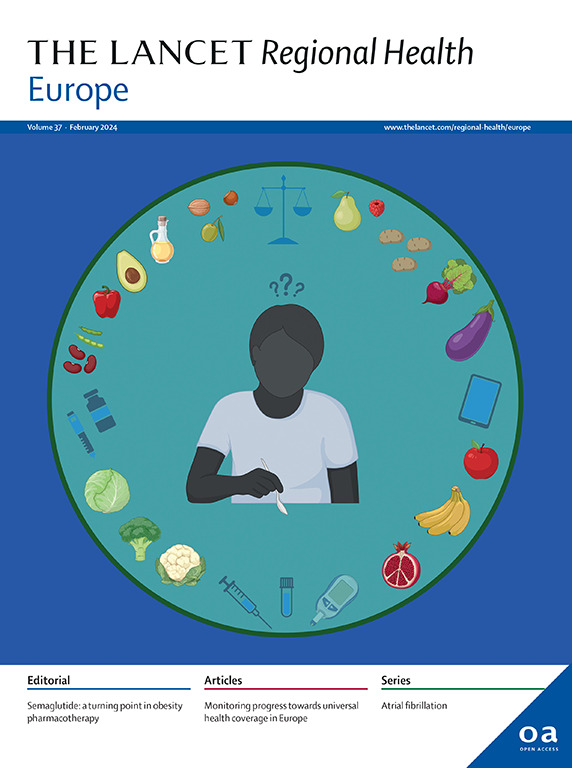欧洲广泛耐药结核病的治疗结果:一项回顾性队列研究
IF 13
Q1 HEALTH CARE SCIENCES & SERVICES
引用次数: 0
摘要
背景2021年,世界卫生组织修订了广泛耐药结核病的定义。我们的目的是确定欧洲广泛耐药结核病患者的治疗结果。方法本观察性、回顾性队列研究纳入世界卫生组织欧洲地区2017 - 2023年诊断为广泛耐药结核病的患者。参与中心连续收集广泛耐药结核病患者的详细个人数据。采用meta和回归方法分析数据,考虑到国家间的异质性。结果:在11003例耐多药/利福平耐药结核病患者中,来自16个国家的188例(1.7%)为广泛耐药结核病。其中,贝达喹啉耐药菌株占48.4% (n = 91/188),利奈唑胺耐药菌株占34.0% (n = 64/188),两种菌株均耐药菌株占17.6% (n = 33/188)。抗结核方案的个体组成变化很大,有151种不同的药物组合。在156/188例(83.3%)可获得治疗结果的患者中,成功结局的总百分比为40.2%(95%可信区间[95% CI] 28.4% - 53.2%)。在治疗结果不成功的患者(101/156)中,大多数经历治疗失败(n = 57/156[合并比例37.1%],95% CI: 26.1% - 49.7%)或死亡(n = 30/156[合并比例21.3%],95% CI: 15.7% - 28.2%)。在调整疾病严重程度后,每增加一种可能有效的药物都降低了不成功结果的几率(调整优势比:0.65,95% CI: 0.45 - 0.96) (p = 0.026),而在中高收入国家接受治疗比在高收入国家接受治疗增加了不成功结果的几率(调整优势比:13.7,95% CI: 3.7 - 50.2) (p <;0·001)。与其他水平的耐药相比,广泛耐药结核病的治疗结果明显更差。广泛耐药结核病患者中只有四成获得了成功的治疗结果。这些发现强调需要适当的、个性化的治疗方案和优化的药敏试验。本文章由计算机程序翻译,如有差异,请以英文原文为准。
Treatment outcomes of extensively drug-resistant tuberculosis in Europe: a retrospective cohort study
Background
In 2021, World Health Organization revised of definition of extensive drug-resistant tuberculosis. We aimed to determine treatment outcomes of individuals affected by extensively drug-resistant tuberculosis in Europe.
Methods
This observational, retrospective cohort study included patients diagnosed with extensively drug-resistant tuberculosis in the World Health Organization European Region from 2017 to 2023. Participating centres collected consecutive, detailed individual data for extensively drug-resistant tuberculosis patients. Data were analysed with meta- and regression methods, accounting for between-country heterogeneity.
Findings
Among 11,003 patients with multidrug-resistant/rifampicin-resistant tuberculosis, 188 (1·7%) from 16 countries had extensively drug-resistant tuberculosis. Of these, 48·4% harboured strains with resistance to bedaquiline (n = 91/188), 34·0% to linezolid (n = 64/188), and 17·6% to both (n = 33/188). The individual composition of anti-tuberculosis regimens was highly variable, with 151 different drug combinations. Among the 156/188 (83·0%) patients with available treatment outcomes, the pooled percentage of successful outcomes was 40·2% (95% confidence interval [95% CI] 28·4%–53·2%). In patients with unsuccessful treatment outcomes (101/156), most experienced treatment failure (n = 57/156 [pooled proportion 37·1%], 95% CI: 26·1%–49·7%) or death (n = 30/156 [pooled proportion 21·3%], 95% CI: 15·7%–28·2%). After adjustment for disease severity, each additional likely effective drug decreased the odds of unsuccessful outcomes (adjusted odds ratio: 0·65, 95% CI: 0·45–0·96) (p = 0·026), whereas being treated in an upper-middle-income country increased the odds of unsuccessful outcomes compared with being treated in a high-income country (adjusted odds ratio: 13·7, 95% CI: 3·7–50·2) (p < 0·001). Compared with other levels of drug resistance, treatment outcomes were significantly worse for extensively drug-resistant tuberculosis.
Interpretation
Only four out of ten patients affected by extensively drug-resistant tuberculosis achieved successful treatment outcomes. These findings highlight the need for adequate, individualised treatment regimens and optimised drug susceptibility testing.
Funding
None.
求助全文
通过发布文献求助,成功后即可免费获取论文全文。
去求助
来源期刊

Lancet Regional Health-Europe
Multiple-
CiteScore
19.90
自引率
1.40%
发文量
260
审稿时长
9 weeks
期刊介绍:
The Lancet Regional Health – Europe, a gold open access journal, is part of The Lancet's global effort to promote healthcare quality and accessibility worldwide. It focuses on advancing clinical practice and health policy in the European region to enhance health outcomes. The journal publishes high-quality original research advocating changes in clinical practice and health policy. It also includes reviews, commentaries, and opinion pieces on regional health topics, such as infection and disease prevention, healthy aging, and reducing health disparities.
 求助内容:
求助内容: 应助结果提醒方式:
应助结果提醒方式:


